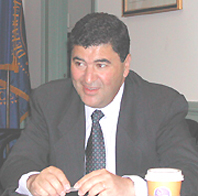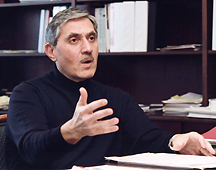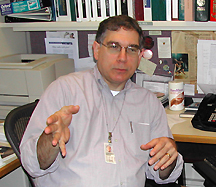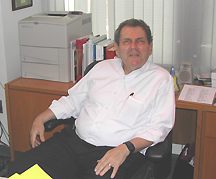
| T H E N I H C A T A L Y S T | S E P T E M B E R – O C T O B E R 2003 |
|
|
|
CARTOGRAPHERS DRAFT NIH RESEARCH ROAD MAP |
|
 |
Before "road map" became the catchword for a Middle East peace plan, NIH Director Elias Zerhouni used the term to describe his nascent plans for redirecting NIH research (see "Roadblocks, Road Maps, and ‘The Perfect Storm,’" The NIH Catalyst, January-February 2003). At the June meeting of his Advisory Committee, Zerhouni and some of his chief cartographers presented in greater detail some of the research road map’s byways and smaller avenues.
The road map is the product of 16 working groups comprising more than 300 NIH and outside experts and chaired by IC leaders. It emphasizes new tools and building blocks to explore individual molecules and whole systems; multidisciplinary, cross-institute research; and substantial expansion of translational research.
From
Road Blocks
To
Building Blocks
NIDDK Director Allen Spiegel elaborated the goals of the building-block initiative—to characterize and elucidate the roles of all functional elements in genomic DNA, RNA species, proteins, carbohydrates, lipids, and metabolites in multiple organisms.
He cited NIDDK research showing that glycolipids have metabolic, structural, and signaling properties as an example of uncovering the multiple roles that molecules may have.
Increased access to tens of thousands of small molecules through the creation of new molecular libraries, Spiegel said, will most certainly expand the scope of pharmaceuticals, which currently target fewer than 500 gene products.
The solving of the 3-D structure of the integral membrane protein rhodopsin is a model of what the road map will achieve, Spiegel said. He noted that although membrane proteins are the targets of between 40 and 60 percent of current pharmaceuticals, very little structural information is known about this class of molecules (see story.).
The image we now have of these key proteins, Spiegel said, is akin to a 19th-century daguerreotype, but what we want to produce is a motion picture.
From
Solo
To
Ensemble Performance
NIDCR Director Lawrence Tabak presented the road map’s vision of its drivers—that is, multidisciplinary and interdisciplinary research teams. It is NIH’s responsibility to break down any cultural or administrative barriers to multidisciplinary research and to identify research problems that transcend the focus of several ICs. The road map calls for the creation of trans-NIH committees to address these issues.
Emphasis is also placed on training investigators to be conversant in several fields and, especially, on the creation of several new granting mechanisms to accelerate the funding of innovative, high-risk, and multidisciplinary and interdisciplinary research.
 |
 |
 |
Translational
Research:
From
Cross-NIH to Cross-Country
NIAMS Director Stephen Katz presented the final aspect of the road map, a series of proposals designed to streamline and expand clinical research.
Translational research would benefit from enhancement of the clinical research infrastructure across the country. This would include the better integration and coordination of clinical research networks and the expansion of their current missions.
Katz also talked about the establishment of 20 to 30 regional Translational Research Centers, each providing core support in biostatistics, pharmacogenetics, novel reagent preparation, animal toxicity testing, and other services.
The behavioral and social sciences would be tapped to develop improved means of assessing clinical outcomes, including quality of life measures.
To bolster clinical research and accelerate the process for performing clinical studies, NIH would work with other federal agencies and with industry to harmonize and simplify many of the current regulatory burdens.
Rules and procedures governing existing national and international genetic and histological repositories would be standardized, and infrastructure would also be built to increase repository availability within the clinical research community.
Finally, the clinical research workforce needs to be boosted by increased training and by expanding current efforts throughout the ICs.
There was a general consensus that these initiatives will require some changes in NIH’s approach to basic and clinical research and in granting mechanisms.
Michael Gottesman, deputy director for intramural research, indicated that the flexibility of the intramural program makes it an ideal place for piloting some road map activities and complementing others.
The road map continues to receive congressional blessing: The House of Representatives allocated $45 million in its 2004 budget to the Office of the Director, urging NIH "to maximize the use of the fund to implement the ‘roadmap’ being developed by the NIH to structure its future research portfolio."